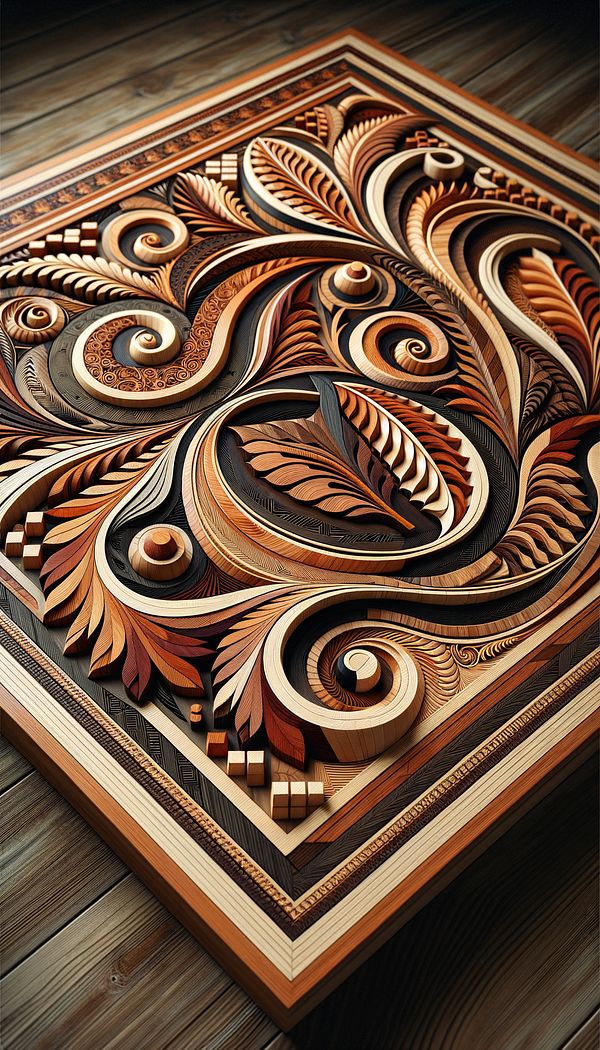What is Intarsia?
Intarsia is a form of wood inlaying that involves fitting together pieces of wood of varying shapes, colors, and species to create intricate patterns or images.
Description
Intarsia, a term with roots in the Italian language, embodies the art of inlaying various types of wood, and sometimes other materials, to fashion complex patterns or pictorial images. This decorative technique, notable for its precision in the fitting of pieces, showcases contrasting colors or grain patterns of wood, resulting in a mosaic-like effect. It's a practice that dates back to the Middle Ages, finding significant use during the Renaissance for decorating the luxurious interiors of wealthy homes, churches, and public buildings. Unlike marquetry, where thin veneers of wood are applied to a surface, intarsia involves embedding sections of wood directly into the substrate, creating a smoother, more integrated appearance.
This meticulous craft not only highlights the natural beauty and variety of wood but also allows for a remarkable depth and three-dimensionality in the design. Modern intarsia has expanded to include materials beyond wood, such as metal, bone, and even precious stones, further broadening its decorative potential. Today, intarsia can be found enhancing furniture, flooring, paneling, and even smaller decorative objects, bringing a unique, artisanal quality to interior spaces.
Usage
In interior design, intarsia is often seen in ornate flooring patterns, detailed inlays on furniture (such as tables and cabinets), and striking wall panels. It can provide a focal point in a room or add a touch of elegance and sophistication to various interior elements.
FAQs
-
What is the difference between intarsia and marquetry?
The main difference between intarsia and marquetry lies in the technique and materials used. Intarsia involves inlaying thicker pieces of wood or other materials into a wood substrate to create an image or pattern, resulting in a more integrated appearance. Marquetry, on the other hand, uses thin veneers applied to the surface of an object, emphasizing patterns rather than pictorial depth.
-
Can intarsia include materials other than wood?
Yes, modern intarsia has expanded to incorporate a variety of materials beyond wood, including metal, bone, and precious stones, allowing for even more elaborate and decorative designs.
-
How is intarsia applied in modern interior design?
In modern interior design, intarsia is used to create intricate patterns and designs on furniture, flooring, and wall paneling. It adds a unique, handmade quality to interiors, often serving as a focal point or an element of luxury and sophistication.
Practical Application
To incorporate intarsia into an interior design project, consider using it as a statement piece or as subtle detailing to add depth and visual interest. For example, an intarsia pattern can transform a plain wooden table into a stunning centerpiece. Always ensure that the colors and materials chosen complement the overall design theme of the room or space.
-
Architectural Elements199 articles
-
Design Styles478 articles
-
Furniture Types599 articles
-
Decorative Techniques322 articles
-
Materials & Textiles360 articles
-
ChesterfieldA Chesterfield is a type of deep-buttoned sofa, with arms and back of the same height.
-
Card TableA card table is a small, folding table typically used for playing card games.
-
StickleyStickley refers to a style of furniture and a furniture manufacturing company known for its role in the American Arts and Crafts movement.
-
VarguenoA vargueno is a type of portable desk with compartments and drawers.
-
Hope ChestA hope chest is a storage chest traditionally used to collect items such as clothing and household linen, by unmarried young women in anticipation of married life.
